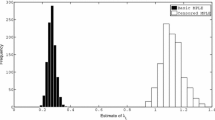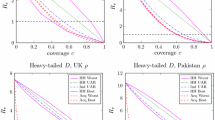Abstract
This paper is concerned with SIR (susceptible → infected → removed) household epidemic models in which the infection response may be either mild or severe, with the type of response also affecting the infectiousness of an individual. Two different models are analysed. In the first model, the infection status of an individual is predetermined, perhaps due to partial immunity, and in the second, the infection status of an individual depends on the infection status of its infector and on whether the individual was infected by a within- or between-household contact. The first scenario may be modelled using a multitype household epidemic model, and the second scenario by a model we denote by the infector-dependent-severity household epidemic model. Large population results of the two models are derived, with the focus being on the distribution of the total numbers of mild and severe cases in a typical household, of any given size, in the event that the epidemic becomes established. The aim of the paper is to investigate whether it is possible to determine which of the two underlying explanations is causing the varying response when given final size household outbreak data containing mild and severe cases. We conduct numerical studies which show that, given data on sufficiently many households, it is generally possible to discriminate between the two models by comparing the Kullback–Leibler divergence for the two fitted models to these data.
Similar content being viewed by others
References
Addy CL, Longini IM, Haber M (1991) A generalized stochastic model for the analysis of infectious disease final size data. Biometrics 47: 961–974
Ball FG, Becker NG (2006) Control of transmission with two types of infection. Math Biosci 200: 170–187
Ball FG, Britton T (2007) An epidemic model with infector-dependent severity. Adv Appl Probab 39: 949–972
Ball FG, Britton T (2009) An epidemic model with infector and exposure dependent severity. Math Biosci 218: 105–120
Ball FG, Lyne OD (2001) Stochastic multitype SIR epidemics among a population partitioned into households. Adv Appl Probab 33: 99–123
Ball FG, Lyne OD (2010) Statistical inference for epidemics among a population of households. Under revision
Ball FG, Britton T, Lyne OD (2004) Stochastic multitype epidemics in a community of households: Estimation of threshold parameter R * and secure vaccination coverage. Biometrika 91: 345–362
Becker NG, Hall R (1996) Immunization levels for preventing epidemics in a community of households made up of individuals of various types. Math Biosci 132: 205–216
Bishop YMM, Feinberg SE, Holland PW (1975) Discrete multivariate statistics. MIT Press, Cambridge
Britton T, Becker NG (2000) Estimating the immunity coverage required to prevent epidemics in a community of households. Biostatistics 1: 389–402
Carrat F, Vergu E, Ferguson NM, Lemaitre M, Cauchemez S, Leach S, Valleron A-J (2008) Time lines of infection and disease in human influenza: a review of volunteer challenge studies. Am J Epidemiol 167: 775–785
Ethier SN, Kurtz TG (1986) Markov processes: characterization and convergence. Wiley, New York
Ferguson NM, Cummings DAT, Cauchemez S, Fraser C, Riley S, Meeyai A, Iamsirithaworn S, Burke DS (2005) Strategies for containing an emerging influenza pandemic in Southeast Asia. Nature 437: 209–214
Keeling MJ, Rohani P (2008) Modeling infectious diseases in humans and animals. Princeton University Press, Princeton
Leroy EM, Baize S, Debre P, Lansoud-Soukate J, Mavoungou E (2001) Early immune responses accompanying human asymptomatic Ebola infections. Clin Exp Immunol 124: 453–460
Mangada MNM, Igarashi A (1998) Molecular and in vitro analysis of eight dengue type 2 viruses isolated from patients exhibiting different disease severities. Virology 244: 458–466
Mehta PN, Chatterjee A (2010) Varicella. eMedicine. http://emedicine.medscape.com/article/969773-overview. Accessed 29 April 2010
Morley DC, Aaby P (1997) Managing measles: size of infecting dose may be important. BMJ 314: 1692
Pellis L, Ferguson NM, Fraser C (2008) The relationship between real-time and discrete-generation models of epidemic spread. Math Biosci 216: 63–70
Staalsoe T, Hviid L (1998) The role of variant-specific immunity in asymptomatic malaria infections: maintaining a fine balance. Parasitol Today 14: 177–178
Author information
Authors and Affiliations
Corresponding author
Rights and permissions
About this article
Cite this article
Ball, F., Britton, T. & Sirl, D. Household epidemic models with varying infection response. J. Math. Biol. 63, 309–337 (2011). https://doi.org/10.1007/s00285-010-0372-6
Received:
Revised:
Published:
Issue Date:
DOI: https://doi.org/10.1007/s00285-010-0372-6
Keywords
- Household epidemic model
- Infector dependent severity
- Kullback–Leibler divergence
- Multitype epidemic
- Varying infection response
- Final outcome data




